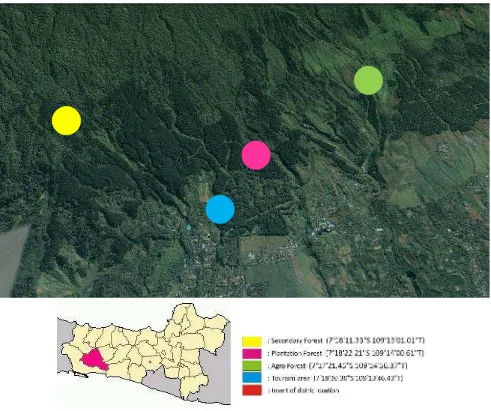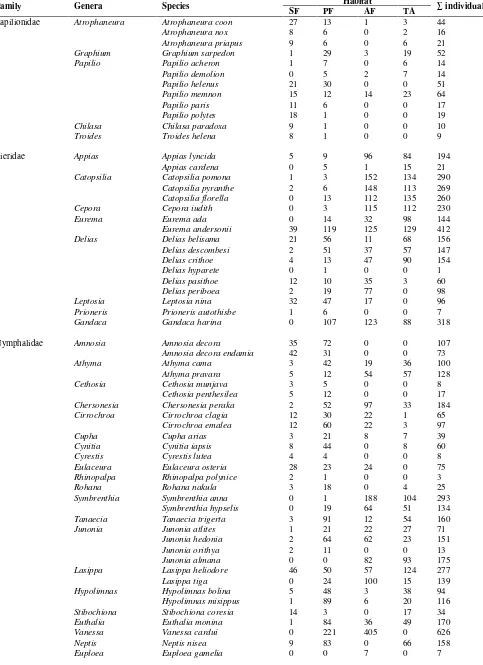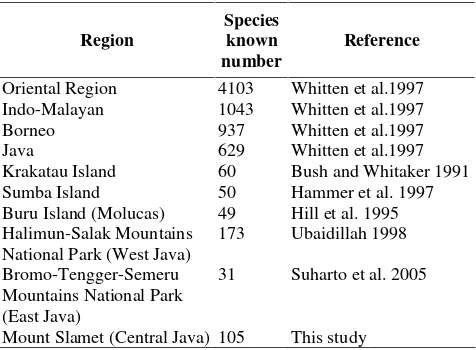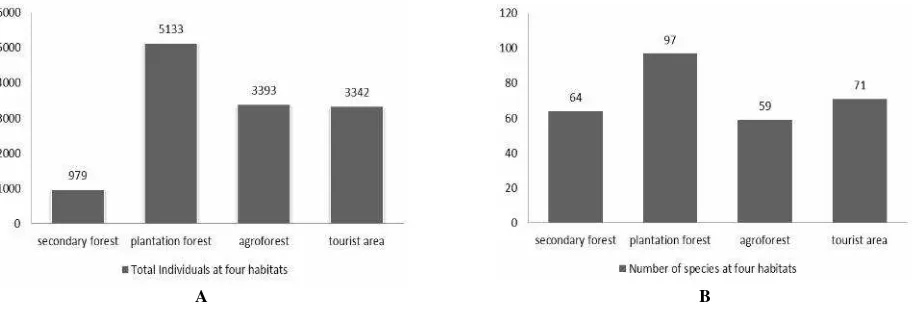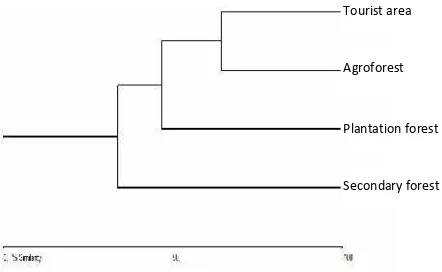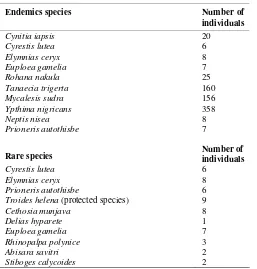Pages: 196-204 DOI: 10.13057/biodiv/d160215
Diversity of butterflies in four different forest types in Mount Slamet,
Central Java, Indonesia
IMAM WIDHIONO
Faculty of Biology, Jenderal Soedirman University. Jl. Dr. Soeparno No. 68, Purwokerto, Banyumas 53122, Central Java, Indonesia. Tel. +62-281-638794, Fax: +62-281-631700, email: [email protected]
Manuscript received: 26 May 2015. Revision accepted: 20 August 2015.
Abstract. Widhiono I. 2015. Diversity of butterflies in four different forest types in Mount Slamet, Central Java, Indonesia. Biodiversitas 16: 196-204. The study was carried out in four different habitat types (secondary forest, plantation forest, agroforest, and tourist area) on the southern slope of Mount Slamet, Baturaden Forest, Central Java, Indonesia from July 2009 to August 2010. A total of 99 species belonging to eight families showed a dominance of Nymphalidae (30 species) followed by Pieridae (17 species), Lycaenidae (15 species), Papilionidae (13 species), Satyridae (11 species), Danaidae (6 species), Amathusidae (4 species), and Riodinidae (3 species). From the 99 butterflies species found on the southern slope of Mount Slamet, 32 species (30%) were specific to the forest, whereas 63 species (60.6%) were common to all habitats sampled, and the last 10 species (9.4%) were endemics species with one protected species (Troides helena). The present results was showed that butterflies diversity, abundance, and endemism is still relatively high, representing 18% of all butterfly species found in Java and supporting 71.4% endemic species found in Central Java. The plantation forest were contributed the highest diversity and abundance of butterfly species, whereas the agroforest showed the lowest diversity, abundance, and endemism. Among all habitats surveyed, the secondary forest represented the most suitable habitat for biodiversity conservation and maintenance of rare and endemic species.
Keywords:Butterfly, Central Java, diversity, endemism, Mount Slamet
INTRODUCTION
Mount Slamet is the second largest volcanic mountain in Java, located in the western region of Central Java Province, with an altitude of 3,432 m above sea level. A large area of Mount Slamet is covered by a variety of forests, including secondary, plantation, agroforests and tourist areas (SFC 1999). Ecologically, forests on Mount Slamet are divided into three types of forest, i.e.: lowland, montane, and subalpine that has diverse vegetation (Sumarno and Girmansyah 2012). The forest areas on Mount Slamet are managed by the State Forest Management Agency (Perum Perhutani). From an ecological viewpoint, forest areas on Mount Slamet is a transition from tropical rainforests in western Java to monsoon forests in eastern Java, which significantly impact on the conservation of biodiversity in Java.
Secondary and plantation forests are usually monocultures of exotic tree species, meaning that they provide poorer habitats than original forests for native butterfly species. Both secondary and plantation forests are expected to play positive roles in biodiversity restoration (Matsumoto et al. 2015), especially when reforestation and natural regeneration are allowed. These secondary and plantation forests can be considered additional conservation areas, as they are in close proximity to natural forests that are known to house of a large population of butterflies. Secondary and plantation forests can also act as buffers and connections between natural forests and other lands, like agroforests and tourist areas. They may improve
connectivity among forest patches, which is important for the maintenance of butterfly diversity.
Java island is a suitable places hosts a diverse butterfly population (583 species, Yukawa 1984; and 629 species, Whitten et al. 1997) with 46 endemic species (Matsumoto et al. 2015), most or all of which depend to some extent upon closed forests (Bonebrake et al. 2010; Sodhi et al. 2010; Vu et al. 2015). From a conservationist viewpoint, patterns in the richness of geographical restricted or endemic butterflies are of particular interest. The diversity of butterfly communities has been studied in different habitat types in different part of Java, such as Gunung Halimun National Park, West Java (Ubaidillah 1998), Mount Tangkuban Perahu, West Java (Subahar et al. 2007), Gunung Salak, West Java (Tabadepu et al. 2008), Gunung Halimun-Salak National Park, West Java (Murwitaningsih and Dharma 2014), and Bromo-Tengger-Semeru National Park, East Java (Suharto et al. 2005). However, few studies have been performed on the diversity of butterfly communities on Mount Slamet. The study was examined the diversity, abundance, and endemism of butterfly on Mount Slamet and to address the importance of secondary and plantation forests for butterfly conservation.
MATERIALS AND METHODS
Study area
of Mount Slamet, Central Java, Indonesia. Geographically, this region lies between 70 18’23 72”S and 109014’ 06 51” at 600-800 m above sea level. The total study area is 267.5 ha, and the forest types are mainly classified as secondary forest (SF, 50 ha), plantation forest (PF, 50 ha), agroforest (AF, 50 ha), and tourist area (AF, 117.5 ha) (Figure 1).
Description of the study site
Secondary forest (SF)
Vegetation in SFs are tropical, rainforest-type vegetation that consists of 19-20 tree species, such as
Palaquium rostratum, Turpinia sphaerocarpa,
Xanthophyllum excelsum, Terminalia catappa, Tarenna incerta, Sterculia campanulata, Spathodea campanulata,
Semecarpus heterophyllus, Planchonia valida,Macaranga rhizinoides, Litsea angulata, Hernandia peltata, Helicia javanica, Gluta renghas, Ficus variegata, F. benjamina,
Fagraea crenulata, Euodia roxburghiana, Erythrina variegata, Elaeocarpus glaber, Dipterocarpus gracilis,
Dendrocnide sinuata, Artocarpus elastica, Antidesma tetrandum, and Aglaia elliptica.
Plantation forest (PF)
PFs are dominated by resin plants (Agathis dammara); other tree species are used for secondary products such as firewood, animal forage, site amelioration, and fodder. Some are planted as border trees, including Leucaena leucocephala, L. glauca, Calliandra californica, and
Acacia villosa. Other trees were planted to increase the heterogeneity of the forest, such as Schima noronhoe,
Pterospermum javanicum, Magnolia blumei, Tarenna
incerta, Antidesma bunius, Macadamia ternifolia,
Swieteniaspp., Michelia montana, Mesua ferrea,Machilus rimosa, Cinnamomum burmanii, and Santalum album.
Agroforest (AF)
AFs were established as soon as the land was clear-cut and the forest management was performed by Perhutani (State Forest Company/SFC), adopting the Taungya system from Myanmar and involving local people (Whitten et al. 1997). Each family of forest farmers received 2 ha of forest land for a duration 3-5 years. On this land, farmers were to plant the main tree species (A. dammara) and food plants, primarily dry land rice, corn, and certain vegetables.
Tourist area (TA)
In addition to forest management techniques that SFC created, tourist or recreational areas to increase the quality of life and prosperity of local people were created. Originally, TAs functioned as campgrounds, but at present, more than 50% of all TAs consist of open gardens with white exotic plant species.
Climatology
The study site receives an annual rainfall of approximately 4500 mm3, representing one of the highest precipitation areas in Indonesia. The long rainy season with precipitation of more than 100 mm3/month ranges from October to May/June. The very short dry season with precipitation of less than 60 mm3/month ranges from July to September. Day light temperatures range from 20 to 28°C.
Sampling procedure
Field surveying of butterfly was conducted from July 2009 to August 2010, following the Modified Pollard Walk Method with kite netting in four distinct habitats of Mount Slamet. Five permanent lines of transects (PLTs) (~ 0.5 km long and 5 m wide) were laid in the four habitat types. Butterflies were captured during sunny days at a constant speed in each transect from 8 am to 12 am local time for four consecutive days. This process was repeated at 30-day intervals, maintaining the same spatial scale in each of the five sampling sites. Identification of butterfly species was used the method described by D’ Abrera (1982, 1985 and 1986). Collected specimens are maintained in the entomology laboratory at Jenderal Soedirman University, Purwokerto, Banyumas, Central Java, Indonesia.
Data analysis
The Shannon diversity index was applied to estimate butterfly diversity along the habitats. This index was calculated using the equation: Hs=-Σpi Inp, where, piis the proportion of individuals found in theith species and ‘In’ denotes the natural logarithm. Species dominance across habitats was estimated using the Simpson’s dominance index to determine the proportion of more
common species in a community or an area with the following formula:Ds =Σsi=1[ni (ni-1)]/[N (N-1)], where
niis the population density of theith species, and N is the total population density of all component species in each site. Comparisons of butterfly species composition between different forest habitats was estimated using single linkage cluster analysis based on Bray-Curtis similarity. Biodiversity Pro version 2 (McAleece et al. 1997) was used for data analysis.
To classify the status of species, the rare species, as defined in this study, are those species represented by fewer than 10 individuals, while the endemic species defined as species which is only found in Java and nowhere else in the world.
RESULTS AND DISCUSSION
The butterfly community at Mount Slamet
A total of 99 butterfly species were recorded at the study site: the southern slope of Mount Slamet (Table 1). The species recorded were obtained from July 2009 to August 2010.
The butterfly species belong to eight families with a dominance of Nymphalidae (30 species, 28.7%) followed by Pieridae (17 species, 16.6%), Lycaenidae (15 species, 15,1%), Papilionidae (13 species, 12.3%), Satyridae (11 species, 10.1%), Danaidae (6 species, 5.5%), Amathusidae (4 species, 3.7%), and Riodinidae (3 species, 3.7%) (Figure 2). This result represents only 18% of the 583 species recorded from Java (Yukawa 1984); 13 species of Papilionidae represent 37.4% of the total species in Java (35 species). Pieridae were represented by 18 species (30%) of a total of 52, and Nymphalidae were represented by by 30 species (15%) from 226 species found in Java. Additionally, Satyridae were represent by 11 species (30%) from 44 species, Danaidae were represented by 6 species (16.6%) from 36 species, Amathusidae were represented by 4 species (30%) from 13 species, Riodinidae were represented by 4 species, and Lycaenidae were represented by 18 species (10.6%) from 179 species found in Java.
A B
Table 1. Butterfly species captured on Mount Slamet from July 2009 to August 2010 in different forest types. Habitat
Family Genera Species
SF PF AF TA ∑ individuals
Atrophaneura coon 27 13 1 3 44
Atrophaneura nox 8 6 0 2 16
Atrophaneura
Atrophaneura priapus 9 6 0 6 21
Graphium Graphium sarpedon 1 29 3 19 52
Papilio acheron 1 7 0 6 14
Papilio demolion 0 5 2 7 14
Papilio helenus 21 30 0 0 51
Papilio memnon 15 12 14 23 64
Papilio paris 11 6 0 0 17
Papilio
Papilio polytes 18 1 0 0 19
Chilasa Chilasa paradoxa 9 1 0 0 10
Troides Troides helena 8 1 0 0 9
Papilionidae
Appias lyncida 5 9 96 84 194
Appias
Appias cardena 0 5 1 15 21
Catopsilia pomona 1 3 152 134 290
Catopsilia pyranthe 2 6 148 113 269
Catopsilia
Catopsilia florella 0 13 112 135 260
Cepora Cepora iudith 0 3 115 112 230
Eurema ada 0 14 32 98 144
Eurema
Eurema andersonii 39 119 125 129 412
Delias belisama 21 56 11 68 156
Delias descombesi 2 51 37 57 147
Delias crithoe 4 13 47 90 154
Delias hyparete 0 1 0 0 1
Delias pasithoe 12 10 35 3 60
Delias
Delias periboea 2 19 77 0 98
Leptosia Leptosia nina 32 47 17 0 96
Prioneris Prioneris autothisbe 1 6 0 0 7
Pieridae
Gandaca Gandaca harina 0 107 123 88 318
Amnosia decora 35 72 0 0 107
Amnosia
Amnosia decora endamia 42 31 0 0 73
Athyma cama 3 42 19 36 100
Athyma
Athyma pravara 5 12 54 57 128
Cethosia munjava 3 5 0 0 8
Cethosia
Cethosia penthesilea 5 12 0 0 17
Chersonesia Chersonesia peraka 2 52 97 33 184
Cirrochroa clagia 12 30 22 1 65
Cirrochroa
Cirrochroa emalea 12 60 22 3 97
Cupha Cupha arias 3 21 8 7 39
Cynitia Cynitia iapsis 8 44 0 8 60
Cyrestis Cyrestis lutea 4 4 0 0 8
Eulaceura Eulaceura osteria 28 23 24 0 75
Rhinopalpa Rhinopalpa polynice 2 1 0 0 3
Rohana Rohana nakula 3 18 0 4 25
Symbrenthia anna 0 1 188 104 293
Symbrenthia
Symbrenthia hypselis 0 19 64 51 134
Tanaecia Tanaecia trigerta 3 91 12 54 160
Junonia atlites 1 21 22 27 71
Junonia hedonia 2 64 62 23 151
Junonia
Junonia orithya 2 11 0 0 13
Junonia almana 0 0 82 93 175
Lasippa heliodore 46 50 57 124 277
Lasippa
Lasippa tiga 0 24 100 15 139
Hypolimnas bolina 5 48 3 38 94
Hypolimnas
Hypolimnas misippus 1 89 6 20 116
Stibochiona Stibochiona coresia 14 3 0 17 34
Euthalia Euthalia monina 1 84 36 49 170
Vanessa Vanessa cardui 0 221 405 0 626
Nymphalidae
Neptis Neptis nisea 9 83 0 66 158
Danaus aspasia 5 15 0 0 20 Danaus
Danaus vulgaris 7 97 30 11 145
Euploea climena 5 11 2 7 25
Euploea
Euploea gamelia 3 3 7 103 116
Parantica albata 10 16 6 6 38
Danaidae
Parantica
Parantica pseudomelaneus 3 82 0 0 85
Elymnias casiphone 12 25 12 16 65
Elymnias ceryx 1 2 5 0 8
Elymnias hypermnestra 6 13 0 78 97
Elymnias
Elymnias nesaea 6 15 9 22 52
Lethe Lethe europa 64 182 48 62 356
Melanitis leda 45 267 12 54 378
Melanitis
Melanitis zitenius 25 199 1 47 272
Mycalesis Mycalesis sudra 25 413 78 86 602
Ypthima Ypthima nigricans 111 536 561 296 1504
Ragadia Ragadia makuta 89 45 0 0 134
Satyridae
Neorina Neorina krishna 32 29 0 0 61
Abisara kausambi 17 55 0 0 72
Abisara
Abisara savitri 1 1 0 0 2
Riodinidae
Zemeros Zemeros flegyas 2 8 0 0 12
Faunis Faunis canens 90 314 0 0 407
Thaumantis Thaumantis odana 37 79 0 0 116
Amathusia Amathusia taenia 30 101 0 0 131
Amathusiidae
Zeuxidia Zeuxidia luxerii 2 32 0 0 149
Arthopala Arthopalasp. 2 3 12 17 34
Prosotas Prosotas dubiosa 0 26 11 21 58
Dacalana Dacalana vidura 2 8 3 2 15
Nacaduba angusta 0 48 22 23 93
Nacaduba kurava 0 109 57 69 235
Nacaduba
Nacadubasp. 0 4 17 3 24
Surendra Surendra vivarna 0 9 0 7 16
Stiboges Stiboges calycoides 1 1 0 0 2
Heliophorus Heliophorus epicles 28 41 0 44 113
Jamides alecto 12 116 68 79 275
Jamides celeno 3 96 4 20 123
Jamides cunilda 6 20 8 5 39
Jamides cyta 2 16 5 10 33
Jamides
Jamides pura 15 52 19 93 179
Lycaenidae
Poritia Poritia eryconoides 0 59 21 28 108
1203 5088 3469 3234 12994
Table 2.Butterfly on Southern slope of Mount Slamet compared to other Indo-Malayan region
Region
Species known number
Reference
Oriental Region 4103 Whitten et al.1997
Indo-Malayan 1043 Whitten et al.1997
Borneo 937 Whitten et al.1997
Java 629 Whitten et al.1997
Krakatau Island 60 Bush and Whitaker 1991
Sumba Island 50 Hammer et al. 1997
Buru Island (Molucas) 49 Hill et al. 1995 Halimun-Salak Mountains
National Park (West Java)
173 Ubaidillah 1998 Bromo-Tengger-Semeru
Mountains National Park (East Java)
31 Suharto et al. 2005
Mount Slamet (Central Java) 105 This study
(Hammer et al. 1997). The fact indicating that the species assemblages of butterflies at Mount Slamet are dominated by common and widely distributed species in the Indo-Malayan region (Table 2).
The general low species richness found at Mount Slamet in comparison to other parts of Java might also due to the sampling methods used. Net capture methods were used as described by Corbet (1941). One limitation of this method is the restriction to capture of understorey butterflies only, as indicated by the fact that the most abundant species captured were understorey species within the families of Satyridae with 3,924 individuals, followed by Nymphalidae (with 3,737 individuals), Lycaenidae (with 1.290 individuals), and Amathusidae (with 969 individuals). Some canopy fliers might be present but were possibly not captured, as shown by the low abundance of the family Danaidae with 406 individuals and Papilionidae with only 306 individuals. The higher number of individuals of species belonging to family Pieridae might be explained by the fact that several species usually come down to the ground in open habitats. Tropical butterfly communities are divide naturally into two adult feeding guilds (De´ Vries et al. 2012). One guild is composed of species that obtain the majority of their nutritional requirements from flower nectar and include most species of the families Papilionidae, Pieridae, Lycaenidae, Riodinidae, and some groups within Nymphalidae. The second guild is composed of certain genera within Nymphalidae, Satyridae, and Amathusidae, whose adults gain virtually all of their nutritional requirements by feeding on juices of rooting fruits and plant sap (Luk et al. 2011). As the numbers of flower-visiting butterflies increased, fruit-feeding butterflies decreased in abundance towards the canopy. A significant negative relationship between trap height and abundance, as well as the number of recorded species, was found among Satyridae and Nymphalidae (Houlihan et al. 2013). Both the Satyridae and Nymphalidae families were showed decreasing abundance and species number with trap height (Schulze et al. 2001; Fermon et al. 2000). Compared to the count walk method, kite netting results in lower species abundance during research done in Brazil (Caldasa and Robbins 2003).
Habitat preference
From the 99 butterfly species found on the southern slope of Mount Slamet, 32 species (30%) were specific to the forest (Houlihan et al. 2013; Majumder et al. 2013), whereas 63 species (60.6%) were commonly distributed to all habitats sampled, and the last 10 species (9.4%) were endemic to the area. Butterfly species richness between habitats was showed PFs have the highest abundance (97 species) followed by TAs with 71 species, SFs with 64 species, and AFs with only 59 species (Figure 3).
The higher species composition in PFs was due to the variability in environmental factors that affect butterfly movement. High species richness of butterflies in PFs revealed that habitat specificity is directly linked to the availability of host plants for larvae and adults. This results was also in agreement with the prediction that highest diversity should occur in situations of intermediate disturbances when both climax and pioneer species can coexistent (Basset, et al. 2011). This finding contradicted that of Mihindukulasooriya et al. (2014) who found that SFs have the highest species diversity compared to regenerative forests in Sri Lanka, but was in line with other research (Peer et al. 2011; Bergerot et al. 2012; Kumar 2012; Lee et al. 2015). The present study revealed that although SFs had fewer species than PFs, SFs were excellent sites for unique species, which i important from a conservation point of view.
The diversity index (H) was highest in PFs (1.647), followed by TAs (1.655), SFs (1.52), and AFs (1.441). The index dominance (1/D) was highest in TAs and lowest in AFs. The evenness index (J’) was relatively similar in all habitats (0.814-0.894).
Forested habitats, like SFs and PFs were dominated by Nymphalidae, Satyridae, and Amathusidae, whereas open habitats like AFs and TAs were dominated by Pieridae. The dominance of Nymphalidae, Satyridae, and Amathusidae in forested areas may be correlated with the availability of host plants, adult food resources, and microclimate conditions. Many studies have documented the dominance shown by members of Nymphalidae in tropical regions, owing to its polyphagous nature, which helps in all habitats (Sarkar 2011; Harsh et al. 2015).
A B
A high proportion of nymphalid species indicates high host plant richness in the study area (Majumder et al. 2013). The dominance of Nymphalidae in SFs and PFs may also be due to the fact that this family needs a larger spectrum of food resources in both closed and open habitats. Fermon et al. (2005) indicated that nymphalid butterflies have a much higher diversity of phenotypes when larval food plants are more evenly distributed across all habitats.
Species of the Satyridae and Amathusidae families, such as those in subfamilies Morphinae and Satyrinae, exclusively feed on monocotyledonous food plants (Vu et al. 2015). In Southeast Asian rainforests, these plants are restricted to the lower forest layer, which may be one reason why the abundance of Satyrinae and Morphinae is highest in the understorey of closed canopy forests (Harsh et al. 2015). Vu (2007) found that fruit-feeding Satyrinae and Morphinae with relatively uniform phenotypes and a comparatively small set of larval food plants are basically restricted to lower vegetation layers, and many are known to be sensitive to changes in humidity. In this research, it was also found that several species of satyrids are restricted to forested habitats, includingRagadia makuta, Melanitis leda, M. zitenius, Neorina chrisna, Elymnias casiphone, andE. ceryx, whereas other species, such asLethe europa,
Mycalesis sudra, and Ypthima nigricans, are abundant in both forest and agriculture areas. The former group primarily feeds upon a small set of larval foods plants, such as R. makuta, which depends only uponSelaginella and is distributed in closed forests only and is very sensitive to humidity (Vu 2007). The latter group exclusively depends on grasses as food plants, which tend to be abundant in all habitats, and especially open areas.
The abundance of the family Amathusidae decreased in SFs and PFs, preferring more heavily disturbed, open areas, like AFs and TAs. For example, Faunis canens occurred with similar abundance in all habitats, whereasThaumantis odana, Amathusia taenia, and Zeuxidia luxerii occurred at similar abundances in SF and PF habitats. Elliot (1992) expected that adult amathusids butterflies to show a conspicuous preference for the understorey layer of closed forests (Barlow et al. 2007). In Borneo, most amathusids species were recorded near the ground, and 87.9% of the specimens were trapped in the understorey at 0 to 10 m above ground level (Schulze 2001). Amathusid butterflies might be constrained to understorey layers of tropical forests by their food resource requirements. First, their larva are typically bound to grasses (mainly Poaceae), palms (Arecaceae), and others monocotyledonous (Ackery 1988; Elliot 1992). Secondly, the adult butterfly exclusively uses fruits and related food sources that are generally more common on the closed forest floor. Butterfly species restricted to undisturbed forests often have narrower geographical ranges than species found in disturbed habitats (Posa et al. 2008).
Most Pieridae species showed the highest abundance in open areas; significant differences were found for the species Appias cardena, A. libythea, Delias belisama, D. periboea, Catopsilia pyranthe, C. pomona,C. florella, and
Cepora iudith. Both Pieridae species, Eurema andersonii
and Leptosia nina were equally abundant in all habitats except for SFs, where lower capture frequencies were found. Since members of Pieridae are nectar feeding, they rarely penetrate into the dense forest understorey (Sundufu and Dumbuya 2008). Both open and disturbed forest formations that are present in the AFs and TAs appear to support butterfly species that are more commonly associated with ruderal habitats, primarily from the family Pieridae. Widely ranging heliophilous species, which are typical of ruderal habitats, are most likely to successfully establish viable populations in open areas than in closed canopy forests (Chinaru and Joseph 2011). The preference of Pieridae species for open habitats may be correlated with the host plant distribution (Sarkar 2015). Records of species from the Papilionidae, Danaidae, and Pieridae families, all assumed originally to be canopy fliers, may be due to the habits of males to come down to moist floor sites. Many tropical butterfly species (mainly males) take up water and nutrients at moist ground sites, including a number of canopy species (Lawson et al. 2014). Almost all Pierid species found at Mount Slamet were also found at other sites in the Indo-Malayan region, such as Singapore, Malaysian, Thailand, and the Philippines (Matsumoto et al. 2015). This finding indicates that most species dominating open habitats are generalist species distributed throughout the Indo-Malayan region. Generalist species should be simultaneously locally abundant and widely distributed, as a consequence of their ability to exploit a wide range of resources on both local and regional scales. Species with wider geographical distributions may be inherently more adaptable and better able to exploit a wider range of ecological niches; they may therefore be less sensitive to land use changes than are species with narrower distributions (Vu 2007).
Cluster analysis based on the Bray-Curtis single linkage similarity value revealed the percent similarity between species composition across the four habitat types. SFs stood out clearly from the other three habitats and showed a linkage of 28.23%, which represents the lowest similarity. PFs were linked at 44.67% similarity to the cluster habitats of TAs and AFs; a close similarity was found between TAs with AFs, with a linkage of 63.4298%. This result indicates that SFs had the highest diversity of butterflies with a restricted distribution, making it an important butterfly habitat for future conservation efforts (Figure 4).
Figure 4. Bay-Curtis similarity between habitat
Tourist area
Agroforest
Plantation forest
Endemic and rare species
The 99 species of butterfly was found on the southern slope of Mount Slamet, 10 were endemic to Java Island with 542 individuals from three families: Nymphalidae (Cynitia iapsis, Cyrestis lutea, Rohana nakula, Tanaecia trigerta, Neptis nisea, and Euploea gamelia), Satyridae (Elymnias ceryx, Y. nigricans, and M. sudra) and Pieridae (Prioneris autothisbe) (Table 3). Species richness of endemic butterflies in different habitats showed that SFs have the highest species richness with eight species (80%), PFs have six species (60%), TAs have five species (50%), and AFs have the lowest at four species (40%). Abundance of endemic species in the different habitats showed that the most abundant were found in PFs (158 individuals) and the lowest was in SFs (112 species). The 10 endemic species, five were specific to the forest and very rare, indicating that endemic species mostly depend upon forest vegetation and suggesting the need for strict conservation measures. The other five species found in all habitats and were very abundance, especially Y. nigricans and M. sudra
(Widhiono 2015). This result indicates that forests on Mount Slamet support the existence of endemic Java butterflies (30.43%). Then 14 endemic species found in this location amount 71.4%.
Rabinowitz (1981) suggested an eight cell model of abundance or rarity involving large/small habitat range, wide/narrow habitat specificity, and large/small populations where present. Rare species, as defined in this study, are those represented by fewer than 10 individuals. In total, 10 butterfly species were found with fewer than 10 individuals during the entire period and at a different study site (Table 3). They are therefore classified in this study as “rare species”. For example Abisara savitri and Stiboges calycoides (Riodinidae). The rarity ofA. savitri is due to
Table 3. Endemic and rare species of butterfly found on Mount
fact that this species mainly inhabits primary forests and is most abundant at the height of rainy period, a time when little collecting is normally done (Callaghan 2009). Only one species (Troides helena (Papilionidae) is a protected species based on Government Regulation (Peraturan Pemerintah) No. 7/1999 and CITES Appendix II.
The result showed that butterfly diversity, abundance, and endemism on Mount Slamet is relatively high, representing 18% of butterfly species found in Java and supporting 71.4% of endemic species and one protected species (T. helena) found in Central Java. PFs contributed the highest diversity and abundance of butterfly species, and AFs showed the lowest butterfly diversity, abundance, and endemism. Among all forest habitats surveyed, the SFs represent the most suitable habitats for biodiversity conservation and the maintenance of rare and endemic species.
REFERENCES
Ackery PR. 1988. Hostplant and classification: a review of Nymphalid butterflies. Biol J Linn Soc 33: 95-203.
Barlow J, Overal W, Araujo IS, Gardner ST, Peres CA. 2007. The value of primary, secondary and plantation forests for fruit-feeding butterflies in the Brazilian Amazon. J Appl Ecol 44, 1001-1012. Basset Y, Eastwood R, Sam L, Lohman DJ, Novotny V, Treuer T, Miller
S, Weiblen DJ, Pierce NE, Ewin BS, Oowong WS, Kongnoo P, Osorio-arenas MA. 2011. Comparison of rainforest butterfly assemblages across three biogeographical regions using standardized protocols. J Res Lepid. 44: 17-28.
Bergerot B, Merck T, Van Dyck H, Baguette M. 2012. Habitat fragmentation impacts mobility in a common and widespread woodland butterfly: do sexes respond differently? BMC Ecol 12: 5. Bonebrake TC, Ponisio LC, Boggs C, Ehrlich PR. 2010. More than just
indicators: A review of tropical butterfly ecology and conservation. Biol Conserv 143: 1831-1841.
Bush MB, Whittaker RJ. 1991. Kraktau: colonization patterns and hierarchies. J Biogeogr 18: 341-356.
Caldasa C, Robbins RK. 2003. Modified Pollard transects for assessing tropical butterfly abundance and diversity. Biol Conserv 110: 211-219.
Callaghan CJ. 2009. The Riodinid butterflies of Vietnam (Lepidoptera). J Lepidop Soc 63 (2): 61-82.
Chinaru NL, Joseph IC. 2011. A comparative study of diversity of species of butterflies In protected and unprotected habitats of Okwu Ogbaku Forest reserve in Mbaitoli l.g.a., Imo State, Nigeria. JIADC 3 (1):
D’Abrera, B. 1985. Butterfly of the Oriental Region. Part II. Nymphalidae ,Satyridae and Amathusidae. Hill-House, Melbourne.
D’Abrera, B. 1986. Butterfly of the Oriental Region. Part III. Lycaenidae and Riodinidae. Hill-House, Melbourne.
De Vries PJ, Alexander GL, Chacon IA, Fordyce JA. 2012. Similarity and difference among rainforest fruit-feeding butterfly communities in Central and South America. J Anim Ecol 81: 472-482.
Elliot JN. 1992. The Butterflies of the Malay Peninsula. 4th ed. Malayan Nature Society, Kuala Lumpur.
Fermon H, Waltert M, Larsen TB, Dall Asta U, Muhlenberg M. 2000. Effects of forest management on diversity and abundance of fruit feeding Nymphalids butterflies in South Eastern Cote d Ivory. J Insect Conserv 4: 177-183.
Government Regulation (Peraturan Pemerintah) Number 7 Year 1999 concerning the Preservation of Wild Plants and Animals [Indonesian] Hamer KC, Hill JK, Lace LA, Langan AM. 1997. Ecological and
biogeographical effects of forest disturbance on tropical butterflies of Sumba, Indonesia. J Biogeogr 24: 67-75.
Harsh S, Jena J, Sharma T, Sarkar PK. 2015. Diversity of butterflies and their habitat association in four different habitat types in Kanha-pench corridor, Madhya Pradesh, India. IJAR 3 (1): 779-785.
Hill CJ, Kramer KC, Lace LA, Banham, WMT. 1995. Effects of selective logging on tropical forest butterflies on Buru, Indonesia. J Appl Ecol 32: 754-760.
Houlihan PR, Harrison, ME, Cheyne, SM. 2013. Impacts of forest gaps on butterfly diversity in a Bornean peat-swamp forest. J Asia Pac Entomol 16: 67-73.
Khoirun-Nisa AR, Mukti M, Hamzah MH, Mustakim A, Abidin Z. 2013. Butterflies diversity ingreen open space of Malang City, East Java Province, Indonesia. JTLS 3 (2): 104-107.
Kumar A. 2012. A report on the butterflies in Jhansi (u.p.) India. J Appl Nat Sci 4 (1): 51-55.
Lawson CR, Bennie J, Hodgson JA, Thomas CD, Wilson RJ. 2014. Topographic microclimates drive microhabitat associations. At the range margin of a butterfly. Ecography 37: 732-740.
Lee CN, Park JW, Kwon TS, Kim SS, Ryu JW, Jung SJ, Lee SK. 2015. Diversity and density of butterfly communities in urban green areas: an analytical approach using GIS. Zoo Stud 54: 4.
Luk, CL, Kesumawati UH, Ziegler T, Waltert M. 2011.Vertical and horizontal habitats of fruit-feeding butterflies (Lepidoptera) on Siberut, Mentawai Islands, Indonesia. Ecotropica 17: 79-90. Majumder J, Lodh R, Agarwala BK. 2013. Butterfly species richness and
diversity in the Trishna wildlife sanctuary in South Asia. J Insect Sci 13: 79. DOI: 10.1673/031.013.7901.
Matsumoto K, Noerdjito WA, Fukuyama A. 2015. Restoration of butterflies in Acacia mangium plantations established on degraded grasslands in east kalimantan. J Trop For Sci 27 (1): 47-59.
McAleece N, Lambshead PJD, Paterson GLJ. 1997. Biodiversity Pro. The Natural History Museum, London.
Mihindukulasooriya MWDM, Ranawana KB, Majer JD. 2014. Comparison of butterfly diversity in natural and regenerating Forest in a biodiversity conservation site at Maragamuwa, Sri Lanka. J Biol Environ Sci 5 (3): 387-391.
Murwitaningsih S, Dharma AP. 2014. Species diversity of butterflies at Suaka Elang (Raptory Santuary) at Gunung Halimun Salak National Park in West Java. Asian J Conserv Biol 3 (2): 159-163.
New TR, Bush MB, Sudarman HK. 1987. Butterflies from the Ujung Kulon National Park, Indonesia. J Lepidop Soc 41 (1): 29-40. Peer G, van Maanen C, Turbe A, Matsinos Y, Kark S. 2011. Butterfly
diversity at the ecotone between agricultural and semi-natural habitats across a climatic gradient. Divers Distrib 17: 1186-1197.
Posa MRC, Diesmos AC, Sodhi NS, Brooks TM. 2008. Hope for threatened tropical biodiversity: lessons from the Philippines. Bioscience 58: 231-240.
Rabinowitz D. 1981. Seven forms of rarity. In: Synge H (ed) The Biological Aspects of Rare Plant Conservation. Wiley, New York. Rahayuningsih M, Oqtariana R, Priyono B. 2012. Species diversity of
butterflies superfamily Papilionoidae in Hamlet of Banyuwindu, Limbangan Village, Limbangan Sub-district, Kendal District. Jurnal Mipa 35 (1): 11-20. [Indonesian]
Sarkar VK, Sukumar DD, Balakrishnan VC, Kunte, K. 2011. Validation of the reported occurrence of Tajuria maculata, the spotted royal butterfly (Lepidoptera: Lycaenidae), in the Western Ghats, Southwestern India, on the basis of two new records. JoTT 3 (3): 1629-1632.
Schulze CH, Linsenmair KE, Fiedler K. 2001. Understorey versus canopy-patterns of vertical stratification and diversity among Lepidoptera in a Bornean rainforest. Plant Ecol 153: 133-152 SFC [State Forest Corporation/Perhutani] 1999. Management Plan of
forest Conservation. Forest class Agathis: Forest Plan Section II, Yogyakarta [Indonesian].
Sodhi NS, Rose M, Posa C, Lee TM, Bickford D, Koh LP, Brook, BW. 2010. The state and conservation of Southeast Asian biodiversity. Biodiv Conserv 19: 317-328.
Soemarno S, Girmansyah D. 2012. Natural forest area conditions of Mount Slamet, Central Java. In: Maryanto I, Noerdjito M, Partomihardjo T. (eds). Ecology of Mount Slamet: Geology, Climatology, Biodiversity and Social Dynamics. LIPI Press, Jakarta. [Indonesian]
Subahar T, Anzilni F, Amasya D, Choesin N. 2007. Butterfly (Lepidoptera: Rhopalocera) distribution along an altitudinal gradient on mount Tangkuban Parahu, West Java, Indonesia. Raffles Bull Zool 55 (1): 175-178.
Suharto, Wagiyana, Zulkarnain R. 2005. A survey of the butterflies (Rhopalocera: Lepidoptera) in Ireng-Ireng Forest of Bromo Tengger Semeru National Park . Jurnal Ilmu Dasar 6 (1): 62-65. [Indonesian] Sundufu AB, Dumbuya R. 2008. Habitat preferences of butterflies in the
Bumbuna Forest, Northern Sierra Leone. J Insect Sci 8 (64): 1-17. Tabadepu H, Buchori D, Sahari B. 2008. Butterfly record from Salak
Mountain, Indonesia. J Entomol Indon 5 (1): 10-16.
Ubaidillah R, Sofyan MR, Kojima H, Kamitani S, Yoneda M. 1998.
Vu VL. 2007. Ecological indicator role of butterfly in Tam Dao National Park, Vietnam. Russian Entomol J 16 (4): 479-486.
Whitten T, Soeriaatmadaja RE, Alief SA. 1997. The Ecology of Java and Bali. The Ecology of Indonesia Series. Vol. II. Oxford University Press.
Widhiono I. 2015. Diversity and abundance of Java endemics butterfly (Lepidoptera: Rhopalocera) at Mount Slamet, Central Java. Biospecies 7 (2): 59-67. [Indonesian]
